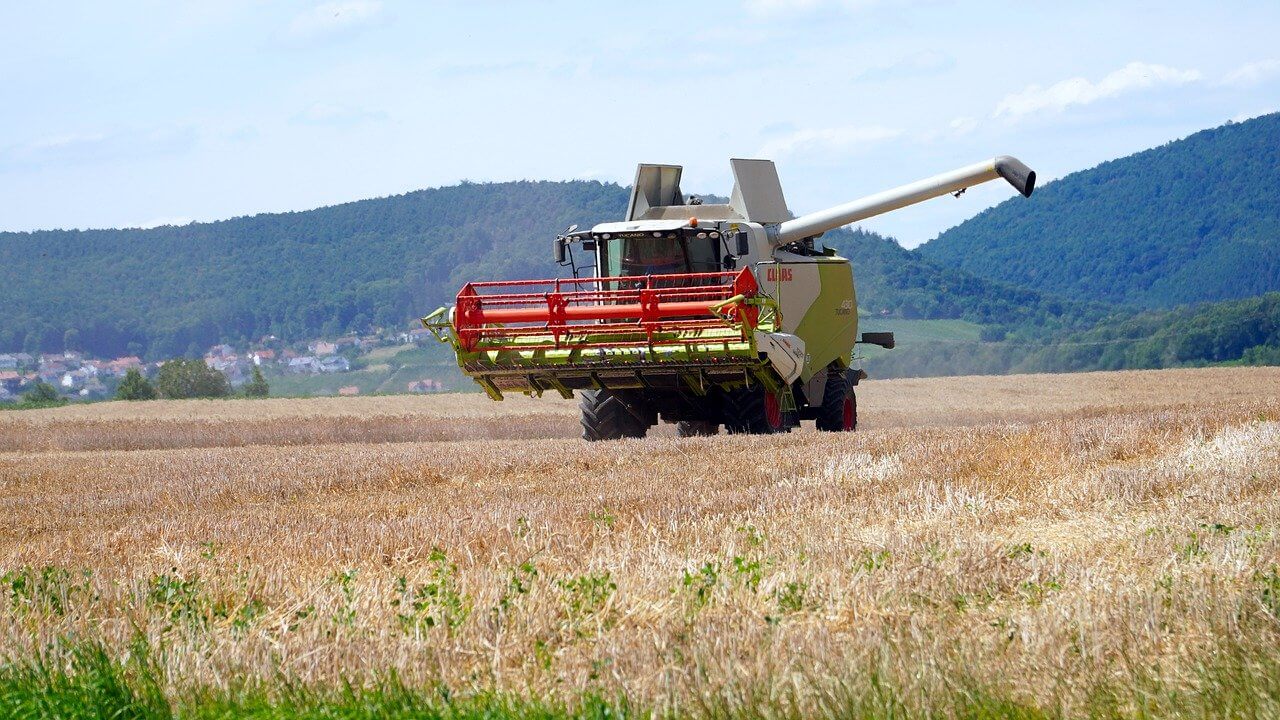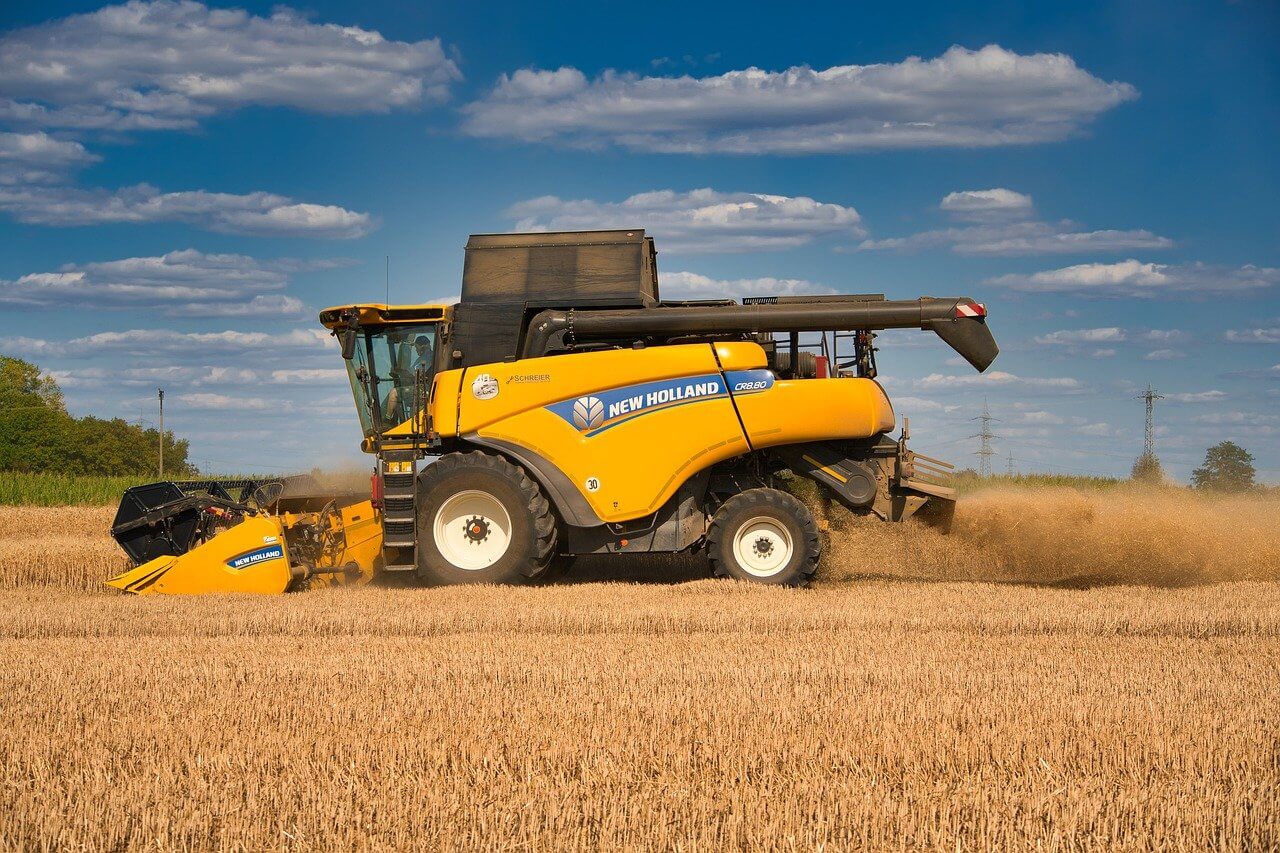When it’s harvest season, you’ll see combines in a wide variety of crop fields all across the US. What is a combine; what do combines do; and how do they work? In this article, we discuss the ways in which this versatile machine works to streamline the harvesting process and help farmers make the most of their crops. Read on to learn more.
What You'll Learn Today
What Is A Combine?

A combine harvester is most often simply referred to as a combine. This is a large farm machine that combines the tasks of harvesting crops, threshing them and cleaning them. The machine leaves the waste straw behind on the ground.
The earliest combines were horse drawn and introduced in Michigan in 1836. They were next used in California. In the 1930s tractor drawn models were developed, and self-propelled models were introduced in the 1950s.
The self-propelled combines became very popular because they were able to cut wide swathes of grains from 8 to 18 feet. This dramatically speeded up and improved the efficiency of grain harvest.
Initially, combines were designed only to harvest wheat, but with the passage of time and more developments they began to be used to harvest all sorts of crops.
Before the introduction of the combine, most of the population in the United States made their living as farm workers, harvesting crops by hand.
The advent of combine harvesters freed these people up by combining the many steps necessary to harvest a crop, separate the grain from the plant and otherwise perform the many steps necessary to get the crops in from the field and make them usable.
How Does A Combine Harvester Work?
A combine harvester can harvest a wide variety of plants. The machine can gather the crops, cut them off at the base and feed them through its threshing drum to shake the grain from the stalk and toss the unwanted material from the back of the machine.
Here are the parts you will find in a combine:
1. Header
This is the part of the machine that cuts through the stalk of a plant right next to the ground. It then moves the plant through the machine. There are different headers for different crops.
2. Spinning augers and conveyors
These parts work together to move the cut plants toward the center of the machine.
3. Thresher
This part beats or threshes the cut plants to shake the grains off the stalks.
4. Grain tank
Conveyors move the separated grain into the grain tank for holding. Other conveyors move the chaff (i.e. leaves, cobs, husks and stalks) in a different direction to be blown out the rear of the machine.
5. Elevator and unloader
Once the grain tank is full, the elevator carries the grain up to the unloader where it is shot into a grain cart.
6. Straw chopper
As the residue is blown out the back of the machine, it is passed through the straw chopper to reduce the debris size and make it uniform and manageable.
All Components Must Work Together Smoothly
Basically, a combine is just a binder style cutting device that is used to deliver grain into a threshing machine that has been modified to work as it moves along through the crop.
The cutting and gathering component of the combine is designed for the purpose of taking in the grain with as little straw as possible. This component is called a header.
The threshing cylinder of a combine rubs the grain across the concave surface removing it from the heads. Some grain manages to slip through and go along with the straw to the straw deck. At this point, it is shaken out and delivered into the cleaning shoe.
Most of the chaff and grain goes straight into the cleaning shoe and is then put through sieves and blown with a blast of air to separate the debris from the grain.
Once it is been blasted with air, the grain falls into the clean grain auger and is conveyed into an elevator and then into a storage tank. The remaining straw falls out the back of the combine.
Different Combine Heads Handle Different Crops

There are different types of combine heads which can be interchanged depending upon the type grain you are harvesting.
1. Standard header
This is also called the grain platform or the platform header. This type of header has a reciprocating knife cutter bar along with a revolving reel that has plastic or metal teeth that cause the cut crop to fall onto the head. At this point, a cross auger is used to pull the crop into the machine’s throat.
This basic header is used for a wide variety of crops such as legumes and some grains.
2. Wheat header
This is a similar type of header but the reel doesn’t have teeth. Wheat headers are also called draper headers because they use rubber or fabric aprons in the place of the cross auger.
The draper header allows the grain to be fed through more quickly than do cross augers. This results in more grain being put through the machine and a higher yield. Even so, in some events standard platform headers are used instead of wheat headers for simple cost-reduction.
3. Dummy heads
These are also known as pickup headers. This type of header is used for crops that have been precut and placed into swathes or windrows. This type of header is most frequently used in Canada and other new northern locations.
4. Corn header
It’s possible to use a standard grain header for corn, but a specialized corn header results in reduced waste. This type of header has snap rolls that are especially designed for stripping the leaves and stalk from the ear.
This results in less material being sent through the throat. Only the husk of the corn must be separated from the ear. The ear of corn is recognized by points between each of the rows in the header.
This type of point may also be seen in row crop heads that are used for harvesting small grains. The points help reduce the amount of weed seed that is picked up during harvesting.
Side-hill Leveling
This type of technology is used to level the machinery when operating on a steep hillside. Developed by John Deere, Case IH and Gleaner, side-hill leveling technology allows efficient operation on hillsides of as great as a 50% slope.
This is a good thing because without it, the machine would lean and cause both the grain and the chaff to slide to one side and be ejected together in a big ball rather than being efficiently separated.
Additionally, side-hill leveling has a safety aspect that prevents the heavy machinery from tipping. Even though this is an excellent type of technology, it is less used today because combines have become even larger and wider than they were in the past. Their width prevents them from becoming unleveled and from tipping.
The Process Of Threshing

Even though there have been many advances both mechanically and technologically in combine design, the process of threshing has remained pretty much the same since the original invention of this piece of heavy machinery.
The header cuts the crop and feeds it through the threshing cylinder. The threshing cylinder is made up of horizontal rasp bars that are fixed across the crops’ path and guide the crop upwards through a turn of 90°.
Following this, rub bars or moving rasp bars continue to pull the crop through concave grates separating the chaff and straw from the grain. Grain heads then fall through fixed concaves and onto sieves. The straw is sent out over the top of the concave onto straw walkers.
Typically there are two sieves, one located above the other. Each one is a flat metal plate that has holes which are set according to grain size. The shaking sieves are mounted at an angle. The holes of the top sieve are typically larger than those of the bottom sieve allowing for more thorough separation of debris from grain.
Straw is carried out through the rear of the machine, and weed seeds as well as crop seeds, along with chaff fall into the second sieve. At this point both crop seeds and chaff fall through and are blown off by a fan. Crop is then carried into the elevator and on into the hopper.
For efficient separation, it’s critical that the concave clearance, the speed of the fan and the sieve size are all correctly set. This may mean making adjustments throughout the harvest to account for uneven ground and a number of other variable factors.
As straw is blown out the back of the machine, heavier materials (e.g. on threshed heads) fall off the front of the seives and go back through the concave to be rethreshed.
You will find the straw walkers above the sieves. These have holes in them that allow any straying grain to fall back through and into the top sieve.
At the end of the process, the straw falls out of the back of the combine. At this point it may be bailed up and used for cattle bedding, or it may be spread out over the ground through the use of rotating straw spreaders to mulch and nourish the soil.